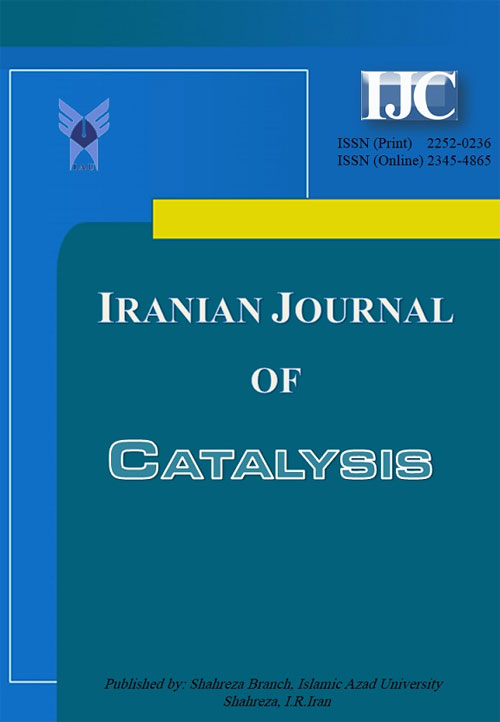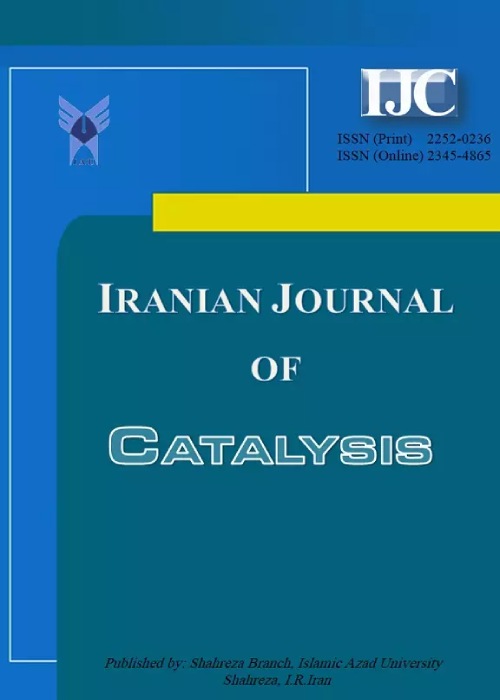فهرست مطالب

Iranian Journal of Catalysis
Volume:6 Issue: 5, Autumn 2016
- تاریخ انتشار: 1395/09/25
- تعداد عناوین: 12
-
-
Page 409A water soluble, Bronsted acid, 5-sulfosalicylic acid as an efficient organocatalyst was used for the synthesis of physiologically active 2-substituted benzimidazole derivatives from o-phenylenediamine and aromatic aldehydes in ethanol at reflux condition. Cost-effectiveness, use of non-hazardous solvents, metal free and commercially available catalyst, single-step, environmentally friendly green method, high conversions, cleaner reaction profiles and simple experimental and workup procedures are the remarkable features of this method.
A water soluble, Bronsted acid, 5-sulfosalicylic acid as an efficient organocatalyst has been used for the synthesis of physiologically active 2-substituted benzimidazole derivatives from o-phenylenediamine and aromatic aldehydes in ethanol at reflux condition. Cost-effectiveness, use of non-hazardous solvents, metal free and commercially available catalyst, single step, environmentally friendly green method, high conversions, cleaner reaction profiles and simple experimental and workup procedures are the remarkable features of this method.Keywords: 5, SSAoPhenylenediamine, Aromatic aldehydes, 2, Substituted benzimidazoles -
Page 415In the present study, Co-ZnO and Co-Ni-ZnO nanoparticles were synthesized by sonochemical methods and the structural and optical properties were investigated through Fourier Transform Infrared spectroscopy (FTIR), UV-Vis spectroscopy, Field Emission Scanning Electron Microscopy (FE-SEM), X-Ray Diffraction (XRD), and Photoluminescence spectroscopy (PL) methods. Morphology of nanoparticles obtained a small granular shape with an average crystallite size of 60 nm. In addition, the direct band gap was calculated using Tauc's approach. Comparing with pure ZnO, the band gap of the doped-ZnO NPs is smaller and depends on the type of dopants. Moreover, photocatalytic activity of all samples was investigated by the degradation of methyl orange (MO) dye under UV irradiation in an aqueous medium. Co-Ni-ZnO possesses excellent photocatalytic activity for the degradation of MO when compared to Co-ZnO and ZnO. In addition, the photocatalytic activity of Co-ZnO improves in the presence of nickel dopant. Moreover, the photocatalyst could be reused for four times without remarkable loss of its activity.Keywords: (Co, Ni), doped ZnO, Band gap, Photocatalytic activity, Sonochemical method
-
Page 423Nano sulfated titania was tested as solid acid heterogeneous catalyst for the synthesis of 4-(Trifluoromethyl) coumarin and coumarin derivatives under solvent-free condition. Factorial design evidenced a positive effect of reaction temperature, amount of catalyst, and solvents. This nano-sized sulfated titania has been prepared by a sol-gel hydrothermal process. The prepared sulfated titania showed high catalytic activity in the synthesis of 4-(Trifluoromethyl) coumarin and coumarin derivatives. This method is of great value because of its environmentally benign character, easy handling, high yields, convenient operation, and green. FT-IR studies show that the catalyst can be reused for acylation without loss of catalytic activity.Keywords: Nano sulfated, titania, Coumarins, Pechmann reaction, Solvent, free condition
-
Page 431The catalytic oxidation of toluene over copper oxide supported on natural diatomite was investigated. The catalyst was prepared by the wet impregnation method and characterized by using the Brunauer Emmett Teller (BET), field emission Scanning Electron Microscopy (FESEM), X-ray diffraction (XRD), X-ray fluorescence (XRF) and Temperature-programmed reduction (TPR) analysis. The highest catalytic performance for airborne toluene oxidation was obtained at 14 wt% Cu loading. The toluene conversion at 270°C and 380°C, were 50% and 90%, respectively. According to the results of GC/MS and formation the CO2 in effluent gas, no intermediates such as CO or other hydrocarbons were detected and the selectivity towards CO2 was almost 100%.Keywords: Diatomite, CuO, Toluene, Catalytic oxidation
-
Page 439A series of copper and cobalt substituted nanospinel ferrites have been synthesized by the hydrothermal method. These compounds were characterized by FT-IR, XRD, EDX, SEM and VSM techniques. All of the synthesized nanospinel ferrites were found to be highly efficient and magnetically recoverable in the solvent-free synthesis of substituted 2,6-(2-hydroxybenzyl)-phenols (trisphenols). A wide range of trisphenols were successfully synthesized from the reaction of 2,6-bis (methylol) phenols (BMPs) and different substituted phenols in the presence of Cu0.5Co0.5Fe2O4 nanocatalyst. The best results were obtained in the presence of Cu0.5Co0.5Fe2O4 and molar ratios of phenol: BMP: catalyst, 3: 1: 0.1 under solvent-free conditions at 90°C. The catalyst could be easily separated using an external magnet. Comparison of the efficiency of Cu0.5Co0.5Fe2O4 with other reported catalytic systems showed that this catalyst has a higher activity for the synthesis of trisphenols. All the products were obtained in short reaction times and high yields. This could be related to the synergistic catalytic effect of copper and cobalt in the nanospinel on the activation of hydroxyl groups of BMPs.Keywords: Spinel ferrites, Magnetic nanocatalyst, Synergistic catalytic effect, Trisphenols, Antioxidant
-
Page 447TiO2 nanoparticles, as a photocatalyst for oxidation of dimethyl methylphosphonate (DMMP) as an organophosphorus simulant of chemical warfare agent, were prepared by using sol-gel method. The prepared nanoparticles were then modified with transition metals in order to decrease the electron-hole recombination and increase the photocatalytic activity. Transition metal ions including Pt, Pd and Ni were used for this purpose. The prepared samples were characterized by different analysis methods, and Photocatalytic mechanism was studied over the unmodified and modified photocatalysts. The effect of some operational parameters such as catalyst dosage, initial DMMP concentration and type and amount of loading the transition metal on the photocatalytic activity was investigated. The results showed that the best photooxidation of DMMP was obtained with 1% Pd/TiO2. The optimum conditions for catalyst dosage and initial DMMP concentration were 20 g L-1 Pd and 0.138 M, respectively.Keywords: DMMP, Nanoparticles, Photooxidation, TiO2, Transition metals
-
Page 455An efficient method is described for the mild and rapid tetrahydropyranylation of alcohols and phenols using a catalytic amount of N-chlorosaccharin (1 mol %) and 3, 4-dihydro-2H-pyran under solvent-free condition at room temperature. Benzylic alcohols and phenols containing electron withdrawing or donating groups in various positions of phenyl ring, cinamyl alcohol, primary, secondary, tertiary as well as cyclic alcohols are converted to their corresponding tetrahydropyranyl ethers in short reaction times and in excellent yields via the present method. Primary benzylic alcohols in the presence of secondary ones and also primary or secondary aliphatic alcohols in the presence of tertiary ones can be efficiently tetrahydropyranylated with excellent selectivity via this method.Keywords: Alcohol, Phenol, Tetrahydropyranylation, N, Chlorosaccharin
-
Page 461For the first time, dioxomolybdenum(VI) complex with the general formula [MoO2L2] containing a N-O bidentate ligands (HL=2-(o-aminophenyl)- benzimidazole) has been used for the oxidation of sulfides. Elemental analyses (carbon, hydrogen, nitrogen), FT-IR and Uv-Visble spectra and 1HNMR analysis agree well with the proposed stoicheiometry of the complex [MoO2L2]. A variety of sulfides were smoothly converted into the corresponding sulfoxide catalyzed by this molybdenum complex. The effect of the reaction conditions on the oxidation was studied by varying the amount of the catalyst, the amount of oxidant (UHP) and solvent type. Good yields with excellent selectivities were obtained in most cases.Keywords: Dioxomolybdenum(VI) complex, Oxidation, Sulfide, UHP
-
Page 467Fe3O4-containing cotton-like mesoporous silica system (Fe3O4@NCSM) was studied with regard to its performance towards the photodecolorization of bromothymol blue (BTB) aqueous solution. The surface properties of the functionalized catalyst were analyzed by a series of characterization techniques like FTIR, XRD, BET, SEM and TEM. The N2 Adsorptiondesorption analysis shows that the mesostructure of silica remains intact after Fe3O4 modifications, while the spectral technique shows the successful encapsulating of the neat Fe3O4 inside the porous silica support. The optimum values of the experimental parameters which affect the degradation efficiency were obtained as: 0.15 g L−1 of the photocatalyst, 25 ppm dye concentration and pH 5.6.Keywords: Nano cotton, shape mesoporous (NCSM), Fe3O4, Heterogeneous photocatalysis, Bromothymol blue (BTB)
-
Page 475The effect of physiological concentrations of caffeine (purified from Persian tea) on adenosine deaminase (ADA) activity at physiological and pathological concentrations of adenosine (as substrate) in 50 mM Tris-HCl buffer (pH 7.3) at 37°C was investigated, using UV-VIS spectroscopy. ADA exhibited a bi-phasic activity behavior and both phases showed positive cooperativities indicating adenosine has at least two regulatory sites on ADA molecule. We proposed a mechanism for the inhibitory effect of caffeine on ADA catalytic activity by analyzing ADA kinetic behavior at various physiological concentrations of caffeine (10, 30, 70 mM): Caffeine dominantly resulted in decreased catalytic activity of ADA via reducing the positive homotropic effect of adenosine on ADA activity. Surprisingly, it also showed a very weak but significant activatory effect on ADA activity in a concentration-dependent manner. To the best of our knowledge, this is the first report on the dual effect of caffeine on ADA activity.Keywords: Caffeine, Adenosine deaminase, Inhibition, Homotropic effect
-
Page 481This study was aimed at investigating the photocatalytic degradation of ciprofloxacin (CIP) antibiotic in aqueous solution using immobilized ZnO nanoparticles on glass plate. X-ray diffraction, atomic force microscopy, and scanning electron microscopy were applied to characterize the nanoparticles. To do so, the ZnO nanoparticles were synthesized through the chemical precipitation method and were immobilized on a glass plate. The degradation of CIP was under UV-C light irradiation. The effects of operational parameters (initial concentration of CIP, pH, and light intensity) on the activity of synthesized ZnO photocatalyst and the kinetics of reaction were investigated. With the initial concentration of 10 mg L-1 of CIP, pH = 6.8 and light intensity = 42 W m-2, the photodegradation efficiency was found to be 69.5%. The results showed that the reaction followed a pseudo-first-order kinetic. The results of the mineralization studies also represented a decreasing trend of total organic carbon over time.Keywords: ZnO nanoparticles, Advanced oxidation processes (AOPs), Photocatalytic degradation, Immobilization, Ciprofloxacin
-
Page 489The cross-coupling reaction between phenylboronic acid and various types of aryl halides (Suzuki reaction) was carried out using a catalytic amount of a new palladium catalyst (1-benzyl-3-(1-benzyl-1-methylpyrrolidin-1-ium-2-yl) pyridin-1-ium palladium chloride [DBNT][PdCl4]) in poly (ethylene glycol) (PEG-200) in the presence of KOH as the base. This new catalyst was synthesized and characterized by elemental analysis, NMR spectroscopy, UVvisible, and FT-IR spectra. This palladium catalyst is not sensitive to air and moisture, so reactions were carried out without using inert atmosphere at room temperature. The steric and electronic properties of the different substrates had a significant influence on the reaction conditions. This method for the synthesis of biarlys has several key advantages, including mild, environmentally friendly, and phosphine-free reaction conditions, excellent conversions as well as good to excellent yields, facile work-up.Keywords: Palladium, Suzuki reaction, Phosphine, free, Room temperature, Arylboronic acid


